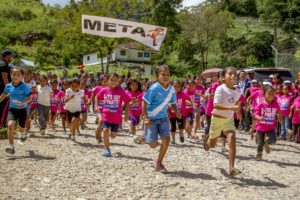Supporting environment surrounding international NGOs
IDJ ENGLISH
『International Development Journal』 2020 April edition
By Kiyoko Ikegami Chair of the Board, Plan International Japan
In the 1990s, civil society was predicted to become “the Third Social Power”. Since then, thirty years has passed and the political and economic environment has changed. But has the environment surrounding civil society, especially Non-Government Organizations involved in international cooperation, improved? Editorial Writer of International Development Journal, Kiyoko Ikegami, considers one of the central issues for the activities of NGOs, “finance and financial stability”.
ODA expenditure through NGOs is only 1.8%
In the case of Japan, the activities of NGOs involved in international cooperationare mainly financially supported by four factors: (1) Official Development Assistance (ODA), (2) Individuals, (3) Foundations and Funds, and (4) Companies.
Regarding (1), according to “the Aid to and through CSOs (2017)” of the Organization for Economic Co-operation and Development (OECD), the share of Japan’s ODA expenditure through Japanese NGOs is only 1.8%. It is very low and the 28th ranking among 30 OECD member countries.
The biggest change during this 30 years is that Japan’s NGO Grants in Association with an International Organization was set up and Grant Assistance for Japanese NGO Projects (N-Ren) has started. It is also a big change that administrative expenses of NGOs have been raised to a maximum of 15%.
As shown in the figure, the Ministry of Foreign Affairs’ support schemes for NGOs are mainly based on the N-Ren and the Japan Platform (JPF) project. The actual amount is increasing. While the ODA budget is sluggish, NGO support projects are said to be increasing.
The N-Ren is a scheme in which NGOs implement areas that NGOs are good at and areas that are difficult to support with ODA. It is possible to involve civil society at home and abroad, and it is hoped that the N-Ren will expand and continue to deepen their understanding of Japan’s international cooperation. JPF is also an NGO-like support scheme whereby NGOs can utilize their networks and knowledge and respond quickly to the needs of disaster and conflict hit areas. In addition, there is support to improve the NGO environment (such as training NGO staff), but the amount is small and decreasing. Support for small international NGOs is an issue for the future.
Donations to the field of international cooperation has slightly decreased
Regarding (2), although it has been said that donation culture has not taken hold in Japan, shortly after the Great East Japan Earthquake, donations from individuals in FY2011 amounted to 1.0182 trillion yen. According to the Japan Fundraising Association’s “White Paper on Donations 2017”, it was 775.6 billion yen in 2016. However, compared to the world, personal donations, including membership fees, are 0.14% of nominal GDP in Japan, 0.5% in South Korea, and 1.44% in the United States. Japan is only one tenth that of the United States. Furthermore, according to “the White Paper on Donations 2015”, donations to the field of international cooperation in Japan account for around 10% of the total, indicating a slight decline.
Among individual donations, regular membership fees are a very important income for NGOs. That’s because continued support allows budgeting over multiple years. But increasing those donations is not easy. The Japan Committee for UNICEF is known for its continuous donations by individuals, but it is still a special case. The challenge is to improve public relations so that many NGOs in Japan can make their names and activities known to the general public, raise awareness and lead to donations.
Support for foundations and funds is mainly overseas
Regarding (3), NGOs currently rely on overseas foundations and funds, because Japanese grant foundations mainly support research for civil organizations and universities operating in Japan. For example, the Bill & Melinda Gates Foundation has been supporting international health policy advocacy for over 10 years. The Open Society Foundation (OSF), founded by investor George Soros, is an organization that outsources the secretariat to the Japan International Cooperation NGO Center (JANIC), is mainly supporting organizations and individuals that address human rights and democracy issues in Japan.
The supports provided by such foundations are based on a well-defined theme, and the support period is one year and must be applied annually. For this reason, they are not so financially stable.
Corporate interest is growing with the SDGs
Regarding (4), according to “the White Paper on Donations 2017”, corporate donations are on an increasing trend, but they are decreasing as a percentage of ordinary income. The amount and trend of NGO support for international cooperation by companies is unknown. But it is true that their interest is growing with the Sustainable Development Goals (SDGs).
In a familiar case, Takeda Pharmaceutical Company Ltd., has provided Plan International Japan with ¥ 1 billion over five years in areas such as helping Syrian refugees and preventing sexual violence. Every year, the company decides on themes to support, conducts document screening, and decides who to support by votes cast from employees around the world. The goal is to promote employee ownership and deepen understanding of international cooperation, and it is truly unique. In the future, if companies are to support NGOs not only in terms of CSR (corporate social responsibility) but also in connection with their main business, it should be closely watched whether not only the amount of support but also the ratio of ordinary income can increase.
Collaboration including “NGO alliance” is important
Various challenges have been identified. The ability of NGOs to stabilize their budgets depends on diversifying their financial resources. It seems that flexible responses for each of the NGOs to realize their purpose is necessary.
In order to diversify resources, for example, it is a good idea to create an “NGO alliance” by sharing expertise and complementing among NGOs, and to apply for N-Ren. The role of NGO alliances may include pooling experts. Why not consider making NGOs working in the same field do joint policy proposals or jointly raise funds?
Collaboration with consulting companies and universities (so-called JVs) as well as NGOs is effective. This has been implemented by some NGOs.
In addition, it could be considered to be the implementing agency for UN-managed projects. You can expect the advertising effect of being a partner of an international organization as well as the implementation management costs as income.
In order to implement these, it is essential to establish expertise. Furthermore, when partnering with NGOs and universities, it also depends on each partner’s ability to work on a large common purpose and philosophy, regardless of methodological differences.
A good example is “the New Partnerships Initiative (NPI)” introduced by the United States Agency for International Development (USAID) in 2018. This is to encourage USAID to diversify its partners and strengthen the independence of the U.S. NGOs that have never or have not worked together before. The selection process begins after the NGO submits a concept paper describing the activity. After the adoption, work on formulation of the implementation plan will be carried out in cooperation with USAID. Since this point is close to the N-Ren system, the ODA responsible organization may try in Japan as well. I look forward to the Japan International Cooperation Agency (JICA), the executing agency to give it a try.
*****以下、日本語原文*****
視点
国際協力NGOを取り巻く支援環境
求められる資金リソースの多様化
国際開発ジャーナル論説委員
(公財)プラン・インターナショナル・ジャパン理事長 池上 清子氏
市民社会が第三の社会的勢力となると予測された1990年代。それから30年を経た今日、政治・経済的な環境は変化してきた。だが、はたして市民社会、特に国際協力に携わる市民組織を取り巻く環境は改善されてきたのだろうか。本誌論説委員の池上清子氏が、市民組織の活動において中心的課題の一つである「資金・財務の安定」について考察する。
NGO通じたODA支出は1.8%
日本の場合、国際協力に携わる市民組織(以後、NGO)の活動を支えているのは、大きく分けて①政府開発援助(ODA)、②個人、③財団・基金、④企業、の4セクターからの支援である。
➀に関して、経済協力開発機構(OECD)の『Aid to and through CSOs (2017)』によれば、日本のNGOを通じたODAの支出額の割合は1.8%にとどまり、OECD加盟国30カ国の中で28位と低い。これは、明らかに改善の余地がある。30年前からの大きな変化と言えば、日本NGO連携無償資金協力(N連)が始まり、その運営管理費が最大15%に引き上げられたことくらいだろうか。
外務省のNGOに対する支援スキームは、図に示す通りN連と(特活)ジャパン・プラットフォーム(JPF)事業が大きな柱となっており、実績額は増加傾向にある。ODA予算が伸び悩んでいる中、増加しているのはNGO支援事業であると言われる所以である。
N連は、日本のNGOが開発途上国で実施する経済・社会開発事業に資金協力を行うもので、NGOが得意とする分野やODAでは支援しにくい領域などをNGOが実施するスキームだ。国内外の市民社会を巻き込むことが可能であり、日本の国際協力の理解を深める意味でもN連の拡大や継続が望まれる。JPFも、NGOが持つネットワークや知見が発揮されること、災害や紛争地域のニーズに素早く対応できるという意味で、NGOらしさが示される支援スキームであろう。
この他、NGO環境整備のための支援(NGO職員の育成など)もあるが、金額は少なく、減少傾向でもある。小規模の国際協力NGOへの支援は今後の課題だ。
国際協力分野への寄付は微減
②に関して、日本は寄付文化が根付いていないと言われてきたが、東日本大震災の直後、2011年度の個人からの寄付は1兆182億円に上った。その後、寄付額は一時減ったものの、最近また増加傾向にあり、(特活)日本ファンドレイジング協会の「寄付白書2017」を見ると2016年は7,756億円となった。しかし世界と比較すると、会費を含む個人寄付の総額は名目GDP比で日本は0.14%、韓国が0.5%、米国は1.44%で、日本は米国の10分の1の少なさである。さらに言えば、「寄付白書2015」によると日本では国際協力分野への寄付は全体の10%前後であり、微減傾向となっている。
個人からの寄付の中でも、定期的に支払われる会費はNGOにとって非常に重要な収入となる。それは、継続して支援があることにより、数年間を見通した予算立てが可能になるからだ。だが、そうした寄付を増やすのは容易ではない。(公財)日本ユニセフ協会は個人の継続寄付が多いことで知られるNGOであるが、やはり特殊なケースであろう。課題としては、日本の多くのNGOが名前や活動内容を一般の人に知ってもらい認知度を上げて寄付につなげる広報力の向上だ。
財団・基金の支援は海外が中心
③について、日本の助成財団は国内で活動する市民組織や大学への研究支援が中心であるため、NGOは海外の財団や基金に頼っているのが現状だ。例えば、ビル&メリンダ・ゲイツ財団は国際保健に関する政策提言活動に関して10年以上、支援している。投資家ジョージ・ソロス氏が設立したオープン・ソサエティ財団(OSF)は、認定NPO法人 国際協力NGOセンター(JANIC)に事務局業務を委託し、主に日本国内の人権・民主主義の課題に取り組む団体・個人を支援している。
財団・基金による支援は明確なテーマが設定された上で行われるが、支援期間は1年で、毎年申請する必要がある。このため、安定的な資金とは言えない部分がある。
SDGsに伴い企業の関心高まる
④については、「寄付白書2017」によると法人の寄付も増加傾向にあるが、経常所得比では減少している。企業による国際協力に関するNGO支援の金額や傾向は判明していないが、持続可能な開発目標(SDGs)と相まって関心が高まっていることは事実であろう。身近な事例で恐縮だが、武田薬品工業(株)はプラン・インターナショナル・ジャパンに対して、シリア難民支援や性暴力防止などの分野に5年間で10億円の支援をしている。同社は毎年、支援テーマを決めて書類選考などを行い、世界中の社員による投票で支援先を決めている。社員のオーナーシップを促進し、国際協力への理解を深めることも目的としており、実にユニークである。今後、企業がCSR(企業の社会的責任)の視点だけでなく本業との関連でNGOを支援していくのであれば、支援額だけでなく経常所得比でも増加傾向にできるかどうかが注視される。
“NGO連合体”など連携がカギ
さまざまな課題も見えてきたが、NGOが予算を安定化できるかどうかは、資金面でのリソースの多様化が実現できるかどうかにかかっている。リソースの可能性をつぶさずに柔軟に対応することが、安定化につながると思われるからだ。
リソースを多様化するためには、例えば、専門性を出し合いNGO間で補完しあって“NGO連合体”を構成して、N連などに応募することも一案だ。NGO連合体の役割としては専門家をプールすることなども含まれよう。同じ分野で活動するNGOが合同で政策提言をしたり、共同で資金調達を図ったりなども検討してはどうだろうか。
NGO同士だけでなく、コンサルティング会社や大学との連携(いわゆるJV)も効果的だ。これは、すでに実施しているNGOもある。
このほか、国連が手掛ける案件の実施機関となることも検討できよう。国際機関のパートナーであることによる宣伝効果と、収入としての実施管理費が期待できる。
これらを実施するには、人材育成を含む専門性の確立が必須条件である。さらに言えば、NGOや大学などと連携する場合、それぞれのパートナーが方法論などの多少の差異にこだわらず、大きな共通の目的や理念に基づいて協働できるかどうかにもかかっている。
参考になる事例としては、米国国際開発庁(USAID)が2018年に導入した「新パートナーシップ・イニシアチブ」(New Partnerships Initiative: NPI)がある。これは、USAIDが連携先の多様化を目指し、今まで連携したことがない、または連携度が低い米国NGOの強化と自立を促進するものだ。NGO側から活動内容のコンセプトペーパーが提出されてから選考プロセスが始まる。採択後、実施計画の策定、ローカルNGOの具体的連携などはUSAIDと協働しながら進める。この点はN連とも近いので、日本でもODAの担当機関が試みてもよいのではないか。実施機関である国際協力機構(JICA)に期待したい。
『国際開発ジャーナル』2020年4月号掲載記事



